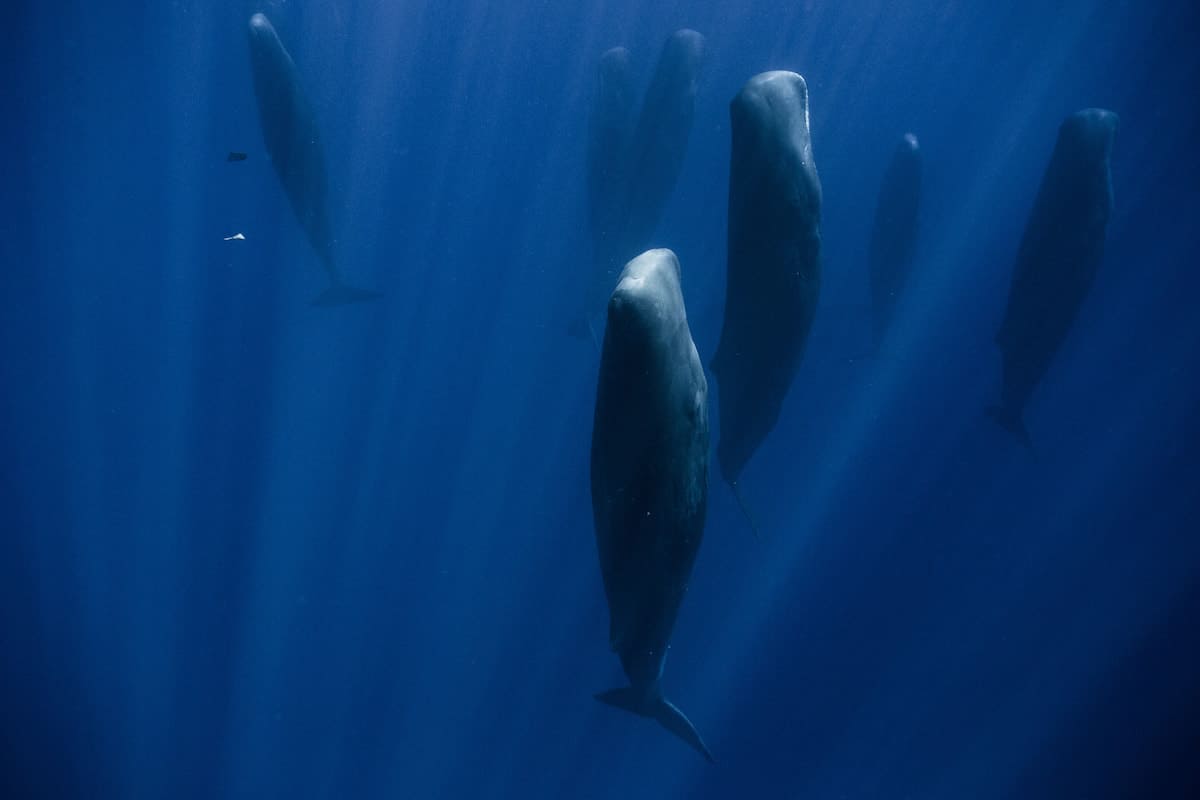Imagine swimming in the open ocean and looking down to find a large group of whales floating motionless in a vertical position — eerie. Do you know why whales sleep vertically? It’s actually an interesting phenomenon that scientists are still trying to figure out. Some species of whale sleep in this position, whereas others rest horizontally. Let’s take a look at some of the reasons why whales might sleep this way and some of the other interesting facts about their sleep habits!
What Whales Sleep Vertically?
As you now know, some whales sleep vertically, with their eyes looking up toward the water’s surface and their tails toward the depths below. The sperm whale is a prime example of this type of slumber. But why do they do it? Scientists aren’t sure, but there are several theories.
They Don’t Sleep for Long
Most animals require sleep to function properly, and whales are no different. Whales depend on oxygen to live, so sleeping underwater might seem challenging, but most have figured out the method that works best for them, and for some, that means sleeping vertically.
Whales typically never spend more than 15 to 20 minutes asleep at one time. They simply have to come up for breath at some point, so they’ve adapted to their environment. Some whales are able to sleep for longer, but tend to sleep floating on the surface with their blowhole exposed.
Sleeping Vertically Makes Waking up Easier
Most of nature is built on efficiency, and sleeping in the wild is no different. Sperm whales might sleep vertically for the simple fact that it makes waking up much easier. When they wake, they don’t have to turn around and search for the surface. Instead, by sleeping vertically, all they have to do is one or two tail kicks and they’re at the surface, getting some much needed air.
Their Heads Are More Buoyant Than Their Tails
Another theory as to why sperm whales sleep vertically has to do with their anatomy. Sperm whales have lungs and other air-filled organs near the head, while the tail end consists mostly of dense muscle and bone. This makes it easier for them to float in a vertical position without having to use much energy, or any energy at all.
If they slept upside-down, they would have to continually readjust to stay facing down, just like a human would. But instead, they completely relax, allowing their body to float wherever it goes, and end up vertical.
It Helps Control Their Breathing
Before going to sleep, sperm whales will dive several lengths of their own body before turning back to the upright position and drifting off to sleep. This helps them control their breathing by staying close to the surface and being ready to grab a breath of fresh air as soon as they need one.
It May Be About Protection
Some scientists believe that sleeping vertically might be a way for some whale species to protect themselves or stay secure within the safety of a group. By sleeping in a group and keeping an eye on each other, they can watch for predators or other dangers.
Do Whales Always Sleep in Groups?
No, whales don’t always sleep in groups. Some species, such as the humpback whale, will sleep alone or in pairs. But for sperm whales and other deep-diving whales, sleeping vertically in a group (also known as a pod) is the norm. Generally, when whales stay in a group, it’s for social interaction and the group brings an added sense of security when sleeping.
How Much Do Whales Sleep?
All in all, whales don’t sleep much. They typically only sleep for 15 to 20 minutes at a time, as this is the length of time that they’re able to go without having to come back up for air. This is one of the adaptations that they’ve made to their underwater lifestyle.
It’s not clear whether whales undergo deep sleep like humans and other mammals, but we can assume that if they do, it’s for a very short period of time. Whales need to always be in control of their blowhole. Without control of their blowhole, water would be allowed to enter into their lunges, and they would not survive. So if a whale entered into a deep state of sleep such as REM sleep, they might lose control and subsequently drown.
Evolution has removed this possibility though, as most whales experience a light form of sleep in which they are able to remain alert while gaining the necessary rest. This type of sleep is known as unihemispheric sleep, in which half of the brain is thought to be asleep while the other half is alert. This helps to control the blowhole while also staying alert to potential dangers that may arise during their sleep.
Whales Aren’t the Only Ones Who Sleep Vertically
Dolphins are another water mammal that sleeps vertically from time to time. Whether they’re in captivity or in the wild, dolphins will sleep both vertically and horizontally for short periods of time.
Do All Whales Sleep Vertically?
No, not all whales sleep vertically. In fact, most whales sleep horizontally. Humpback whales are known to sleep horizontally on the surface of the water for short periods of time, as they need to come up for air every 20 to 30 minutes.
Orcas have also been observed sleeping horizontally on the surface of the water. In fact, sleeping vertically is a characteristic unique to the sperm whale. Blue whales, orcas, and the like find sleeping horizontally much more efficient for them.
The Bottom Line
Whales sleep vertically for a variety of reasons, including staying close to the surface for air, controlling their breathing, and possibly even protection from predators. However, not all whale species sleep vertically. Some, such as humpback whales and orcas, prefer to sleep horizontally on the surface of the water.
Conclusion
Although we still don’t know for sure why whales sleep vertically, there are several theories that scientists have come up with. It could be because it makes waking up easier, or because sleeping this way helps them control their breathing. Another possibility is that it’s a way for them to protect themselves from predators or stay safe within a group. Whatever the reason may be, it’s definitely an interesting phenomenon!





